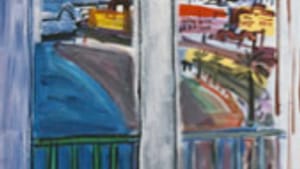Stay in the Loop
BSR publishes on a weekly schedule, with an email newsletter every Wednesday and Thursday morning. There’s no paywall, and subscribing is always free.
Books, gorgeous fruit and women: Matisse's nirvana by the Mediterranean
"Matisse and Modern Art' at the Art Museum

Passing through the dark blue painted vestibule that leads to the gallery housing "Matisse and Modern Art on the French Riviera" a visitor literally emerges from darkness into light. Three generously sunlit rooms of the Perelman Building gallery are dedicated to the mountain, sun and sea inspired work of Henri Matisse, Andre Derain, Raoul Dufy, Emile Bonnard, Chaim Soutine, Moise Kisling, Eduoard Pignon, Marsden Hartley, Louis Marcoussis, William H. Johnson, Pablo Picasso and more.
Though Art Museum regulars will recognize some of the works installed here (most in this exhibition are from the Museum's own collection), to experience them anew in rooms where light cascades in from tall windows, is filtered into softness and then is configured into line and pattern on the floors and walls, is just simply sublime. Matisse— whose works of painting and sculpture dominate and lend coherence in this exhibition— would have much approved of this setting.
The selection and organization of these works, along with accompanying text describing them, suggest that the French Riviera functioned for a time as an environment that fostered heightened creativity among artists. The collaborations and cross-fertilizations of working painters and sculptors continued here for perhaps a whole generation. Then, after German troops occupied the area in 1942, this artistic well simply dried up. Some of the works in this exhibition— for example, Soutine's Landscape, Ceret, painted in 1922, portray a mood, an ominous tension, suggesting that this paradise might soon be disrupted.
As Europe marched to war
Also, the work of the always edgy Pablo Picasso underscores the sense of loss that many artists must have felt as Europe marched to war. His roughly hewn bronze Man With Lamb is positioned to greet the visitor in the aforementioned darkly painted vestibule. This life-sized work of a man with a modernist static stare, skittish lamb tucked under his arm, is said to symbolize sacrifice, hope and salvation.
The last painting exhibited, as if to underscore a chronologic progression of the lightness of some works to the darker visions of others, is Picasso's Woman and Children, painted in 1961 of his then wife Jacqueline Roque, her daughter Cathy, and Paloma, Pablo's daughter with Francoise Gilot. Black lines and patches of the hard hues of teal, pink and green are featured in this "woman" painting.
Here the viewer is invited to consider an altogether different plane of expression where women are concerned. The exhibit begins with celebrations of the female form by Matisse and Bonnard (do not miss the gloriously iridescent After the Shower) and concludes much less satisfyingly with Picasso's Woman with Children. The 20th was in many ways one mean and violent century.
Health problems, woman problems
Matisse was known to have remarked that "painting that looks as if it is made through gritted teeth isn't the only kind worth attention," and indeed the work that rivets me now is his. Hilary Spurling, in her book, Matisse the Master, shows us that Henri, like Pablo, had his share of woman problems. Matisse may also have been far more anxious in constitution than many artists, certainly than Picasso. But this anxiousness never showed up as an overall mood in his painting.
While some might view his work as shallow and decorative, Matisse labored through insomnia and other health problems to achieve his sophisticated "conversations" between colors and patterns, beautifully lined forms that harmonize and contrast so wonderfully. The charm and simplicity— the joie de vivre that we see in Matisse's masterworks of the early 20th Century— were expertly wrought and hard-won.
So many artists have tried to imitate Matisse, but no one has achieved what he has achieved. Action painters and pop artists of this century were supposedly inspired by him, but in my view their contribution pales in comparison.
A world of long shuttered hotel windows
The world of Nice in the 1920s— such as we see in Woman Seated in an Armchair (1923), Still Life (1924) and The Moorish Screen (1921)— was to Matisse one of long shuttered hotel windows, billowing curtains opening out to sunwashed sea views, patterned rugs, wallpapers and tablecloths and female figures— always female, in diaphanous costume, some as odalisques, lending an air of the oriental and the mysterious yet comfortable to the surroundings.
There is the recurring open violin case. Is someone playing? There are the books, and the bowls of gorgeous fruit. These paintings reveal Matisse's nirvana, all demonstrated in a crystallized moment, all angles and color and pattern and planes laboriously paired to please the eye, but always rendered with a lightness. There is a lightness that is achieved in Matisse's work.
Both times that I have gone— once on a sunny day and once on a partly cloudy day— I have come away soul-satisfied. The Cézanne exhibit will open in several weeks, so go to this one now, while traffic is light, and savor Philadelphia's embarrassment of riches utterly and completely.
Though Art Museum regulars will recognize some of the works installed here (most in this exhibition are from the Museum's own collection), to experience them anew in rooms where light cascades in from tall windows, is filtered into softness and then is configured into line and pattern on the floors and walls, is just simply sublime. Matisse— whose works of painting and sculpture dominate and lend coherence in this exhibition— would have much approved of this setting.
The selection and organization of these works, along with accompanying text describing them, suggest that the French Riviera functioned for a time as an environment that fostered heightened creativity among artists. The collaborations and cross-fertilizations of working painters and sculptors continued here for perhaps a whole generation. Then, after German troops occupied the area in 1942, this artistic well simply dried up. Some of the works in this exhibition— for example, Soutine's Landscape, Ceret, painted in 1922, portray a mood, an ominous tension, suggesting that this paradise might soon be disrupted.
As Europe marched to war
Also, the work of the always edgy Pablo Picasso underscores the sense of loss that many artists must have felt as Europe marched to war. His roughly hewn bronze Man With Lamb is positioned to greet the visitor in the aforementioned darkly painted vestibule. This life-sized work of a man with a modernist static stare, skittish lamb tucked under his arm, is said to symbolize sacrifice, hope and salvation.
The last painting exhibited, as if to underscore a chronologic progression of the lightness of some works to the darker visions of others, is Picasso's Woman and Children, painted in 1961 of his then wife Jacqueline Roque, her daughter Cathy, and Paloma, Pablo's daughter with Francoise Gilot. Black lines and patches of the hard hues of teal, pink and green are featured in this "woman" painting.
Here the viewer is invited to consider an altogether different plane of expression where women are concerned. The exhibit begins with celebrations of the female form by Matisse and Bonnard (do not miss the gloriously iridescent After the Shower) and concludes much less satisfyingly with Picasso's Woman with Children. The 20th was in many ways one mean and violent century.
Health problems, woman problems
Matisse was known to have remarked that "painting that looks as if it is made through gritted teeth isn't the only kind worth attention," and indeed the work that rivets me now is his. Hilary Spurling, in her book, Matisse the Master, shows us that Henri, like Pablo, had his share of woman problems. Matisse may also have been far more anxious in constitution than many artists, certainly than Picasso. But this anxiousness never showed up as an overall mood in his painting.
While some might view his work as shallow and decorative, Matisse labored through insomnia and other health problems to achieve his sophisticated "conversations" between colors and patterns, beautifully lined forms that harmonize and contrast so wonderfully. The charm and simplicity— the joie de vivre that we see in Matisse's masterworks of the early 20th Century— were expertly wrought and hard-won.
So many artists have tried to imitate Matisse, but no one has achieved what he has achieved. Action painters and pop artists of this century were supposedly inspired by him, but in my view their contribution pales in comparison.
A world of long shuttered hotel windows
The world of Nice in the 1920s— such as we see in Woman Seated in an Armchair (1923), Still Life (1924) and The Moorish Screen (1921)— was to Matisse one of long shuttered hotel windows, billowing curtains opening out to sunwashed sea views, patterned rugs, wallpapers and tablecloths and female figures— always female, in diaphanous costume, some as odalisques, lending an air of the oriental and the mysterious yet comfortable to the surroundings.
There is the recurring open violin case. Is someone playing? There are the books, and the bowls of gorgeous fruit. These paintings reveal Matisse's nirvana, all demonstrated in a crystallized moment, all angles and color and pattern and planes laboriously paired to please the eye, but always rendered with a lightness. There is a lightness that is achieved in Matisse's work.
Both times that I have gone— once on a sunny day and once on a partly cloudy day— I have come away soul-satisfied. The Cézanne exhibit will open in several weeks, so go to this one now, while traffic is light, and savor Philadelphia's embarrassment of riches utterly and completely.
What, When, Where
“Matisse and Modern Art on the French Riviera.†Through November 1, 2009 at Perelman Gallery, Philadelphia Museum of Art, Benj. Franklin Parkway & 26th St. (215) 763-8100 or www.philamuseum.org.
Sign up for our newsletter
All of the week's new articles, all in one place. Sign up for the free weekly BSR newsletters, and don't miss a conversation.

 Victoria Skelly
Victoria Skelly